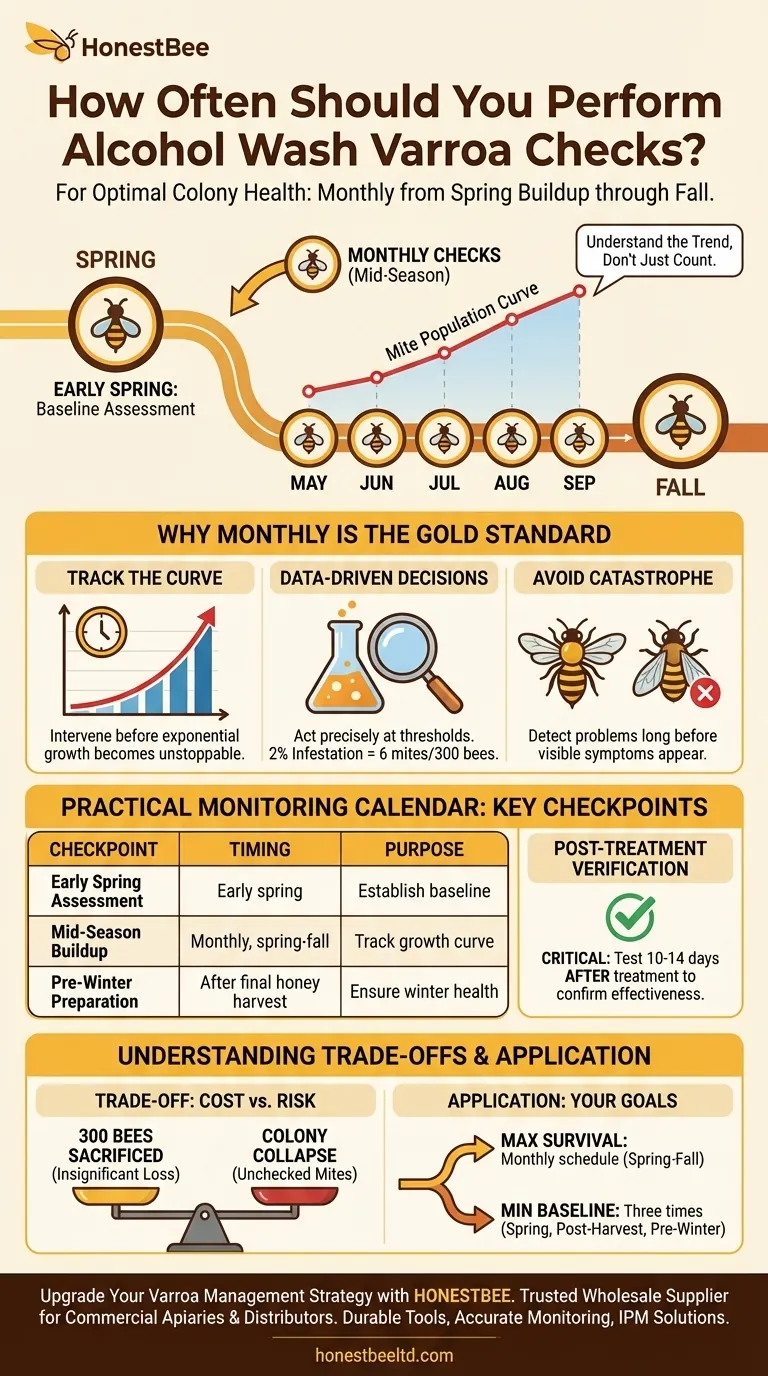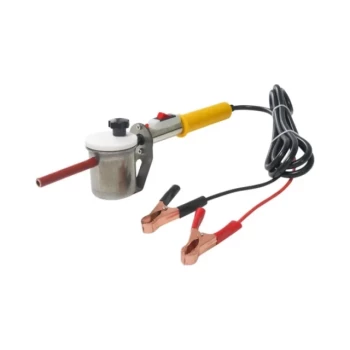For optimal colony health, Varroa mite checks using the alcohol wash method should be performed monthly throughout the main beekeeping season, from spring buildup through fall. This regular cadence provides a clear view of the mite population's growth curve. A follow-up check is also critical 10 to 14 days after any treatment to confirm its effectiveness.
The goal of frequent Varroa testing is not just to count mites, but to understand your colony's infestation trend. Monthly monitoring provides the data needed to treat at the right time—before mite populations reach a critical, damaging level.

Why Monthly Monitoring is the Gold Standard
Simply checking a few times a year can leave you blind to a rapidly escalating problem. A monthly schedule provides the high-resolution data needed for effective, proactive colony management.
Tracking the Mite Population Curve
Varroa mite populations grow exponentially, often peaking in late summer and early fall as the bee population begins to decline. Monthly checks allow you to see this curve developing and intervene before it becomes unstoppable.
Making Data-Driven Treatment Decisions
Monitoring provides the data to act precisely when needed. The common treatment threshold is a 2% infestation rate, which translates to 6 mites in a 300-bee sample. Some beekeepers may tolerate up to 3% (9 mites), but waiting for higher numbers increases risk.
Avoiding Catastrophic Infestation
By the time a colony shows visible signs of high mite loads, such as bees with deformed wings, the infestation is already severe and difficult to control. Monthly alcohol washes detect the problem long before these symptoms appear, which is often too late.
A Practical Monitoring Calendar: Key Checkpoints
While monthly testing is the ideal, certain times of the year are absolutely critical. Think of the "three times a year" guideline as the absolute minimum, not the optimal strategy.
Early Spring Assessment
Your first test of the season establishes a baseline. It tells you how successful your winter mite control was and what level of infestation you are starting with for the year.
Mid-Season Buildup
This is the period for monthly checks. During the spring and summer honey flow, both bee and mite populations are expanding. Regular data is crucial for staying ahead of the infestation curve.
Pre-Winter Preparation
A check after the final honey harvest is one of the most important of the year. This test determines if you need to treat to ensure the colony is healthy enough to raise strong, long-lived winter bees.
Post-Treatment Verification
Never assume a treatment worked. An alcohol wash performed 10 to 14 days after a treatment application is the only way to verify its efficacy and determine if a follow-up is necessary.
Understanding the Trade-offs
Effective Varroa management involves accepting calculated costs to avoid catastrophic losses. The primary trade-off with the alcohol wash method is clear.
The Cost of a Sample
An alcohol wash sacrifices approximately 300 bees. For a healthy colony of 30,000-60,000 bees, this is a statistically insignificant loss, especially when weighed against the risk of losing the entire colony.
The Risk of Under-Monitoring
The true risk isn't sacrificing a few hundred bees; it's the colony collapse that results from unchecked Varroa mites. Infrequent testing creates blind spots where mite populations can explode undetected.
A False Sense of Security
A single low mite count in May does not guarantee safety in August. Mite populations can multiply more than tenfold in a few months. Relying on outdated data is a common and costly mistake.
How to Apply This to Your Hive
Your monitoring frequency should align directly with your goals for your bees. There is no "one-size-fits-all," but there are clear strategies for different priorities.
- If your primary focus is maximum colony survival and productivity: Adopt a monthly alcohol wash schedule from early spring through fall.
- If your primary focus is a minimum-intervention baseline: Test at least three key times: early spring, after the main honey flow, and before final winter preparation.
- If you have just treated for mites: Always perform a follow-up test 10-14 days later to verify the treatment was successful.
Consistent monitoring transforms Varroa management from a reactive guess into a proactive, data-driven strategy.
Summary Table:
| Key Checkpoint | Timing | Purpose |
|---|---|---|
| Early Spring Assessment | Early spring | Establish baseline infestation level |
| Mid-Season Buildup | Monthly, spring through fall | Track mite population growth curve |
| Pre-Winter Preparation | After final honey harvest | Ensure colony health for winter |
| Post-Treatment Verification | 10-14 days after treatment | Confirm treatment effectiveness |
Upgrade Your Varroa Management Strategy with HONESTBEE
Accurate monitoring is the first step; effective treatment is the next. As a trusted wholesale supplier to commercial apiaries and beekeeping equipment distributors, HONESTBEE provides the durable, precision tools you need—including alcohol wash kits, mite testing supplies, and integrated pest management solutions—to protect your colonies and maximize productivity.
Ready to implement a data-driven approach? Contact our expert team today to discuss bulk pricing and tailored equipment solutions for your operation.
Visual Guide

Related Products
- Varroa Easy Check Mite Tester Kit Counter Alcohol Wash Jar
- Durable 12V Oxalic Acid Vaporizer for Varroa Mite Treatment Beehive Beekeeping Tool
- 12V Bee Mite Removal Evaporator Oxalic Acid Vaporizer for Bee Fumigation Treatment 180W Atomization
- Oxalic Acid Vaporizer 12V for Bee Varroa Mite Treatment
- Nicot Queen Rearing Kit for Beekeeping and Grafting in Nicot System
People Also Ask
- How does the Varroa EasyCheck determine mite counts? Achieve Accurate Hive Health Monitoring
- How is the infestation percentage calculated after counting mites? Master Varroa Mite Monitoring
- What is the Varroa EasyCheck and its purpose? Streamline Your Hive Health Monitoring
- What is the Varroa EasyCheck used for? Accurate Mite Monitoring for Healthy Hives
- What are the steps to perform an alcohol wash test after collecting the bees? A Guide to Accurate Varroa Mite Counting



















